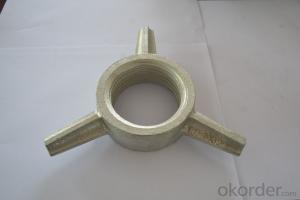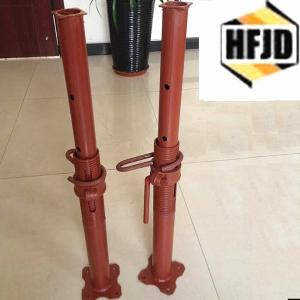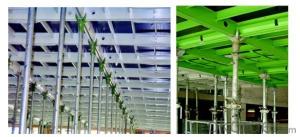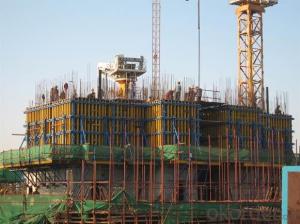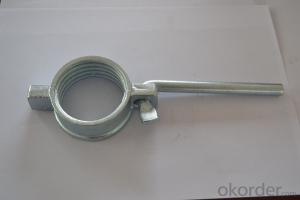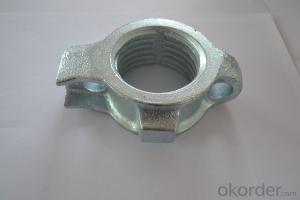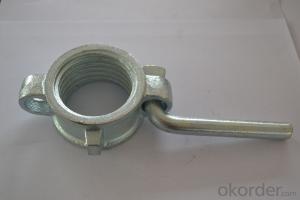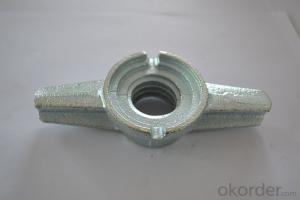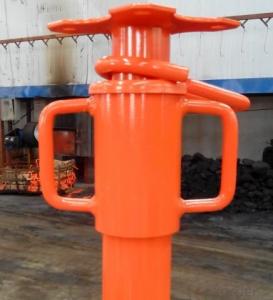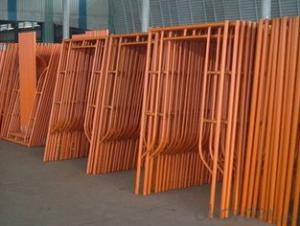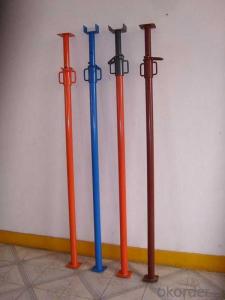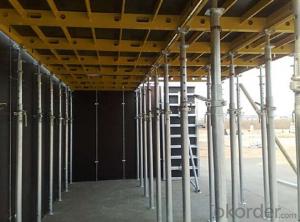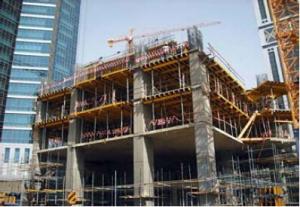OEM Two wing Butterfly Wing Nuts 9
- Loading Port:
- China Main Port
- Payment Terms:
- TT OR LC
- Min Order Qty:
- -
- Supply Capability:
- -
OKorder Service Pledge
OKorder Financial Service
You Might Also Like
Quick Details
| Model Number: | |||||
| Standard: | Type: | Certification: | |||
| Material: | Surface: |
Packaging & Delivery
| Packaging Detail: | Plastic bag, pallet packing, carton box, by customer's requirement |
| Delivery Detail: | within 30days after payment |
Specifications
Two wing Butterfly Wing Nuts
1>Excellent dimension accuracy
2>Finished: per your requirements
3>factory directly supply
Two wing Butterfly Wing Nuts
We supply kinds of metal parts totally according to clients' drawings and samples and special requirement.
1. Material: Ductile iron .
2. Sizes: Inner hole Dia 15/17mm.
We have different sizes ,types of wing nut to meet your needs, save your cost .
3. Weight: 0.35kg,thread pitch: 10.0mm.(or 6.35mm)
4. Surface: White Zinic , Yellow Zinic or painted, self color
5 Thread:casted or machine tap.
1. 12000M2 standard modern workshop guarantee production capability to satisfy the customers needs
2. Our Independent quality control department,Which make sure the quality of all products
3. Our efficient and experienced sales team ,provide friendly and thoughtful service for clients from all over the world
- Q: Can steel props be used in underwater construction projects?
- Yes, steel props can be used in underwater construction projects. Steel is a durable and strong material that can withstand the corrosive effects of water. It is commonly used in underwater construction projects for its structural stability and ability to support heavy loads.
- Q: Are there any regulations or standards for using steel props?
- Yes, there are regulations and standards for using steel props. These regulations vary by country and region, but generally include guidelines for proper installation, load capacity, stability, and maintenance of steel props. Compliance with these regulations ensures safety and helps prevent accidents or structural failures during construction or temporary shoring applications.
- Q: Can steel props be used in temporary support of escalators?
- Yes, steel props can be used in temporary support of escalators. Steel props are typically used in construction and engineering projects to provide temporary support for structures. They are adjustable and can be easily installed and removed. Steel props are strong and durable, making them suitable for supporting heavy loads such as escalators. However, it is important to ensure that the steel props are properly installed and meet the required safety standards to ensure the stability and security of the escalator during the temporary support period.
- Q: Can steel props be used for supporting temporary exhibition or trade show structures?
- Yes, steel props can be used for supporting temporary exhibition or trade show structures. Steel props are strong and durable, making them suitable for providing the necessary structural support for such temporary structures.
- Q: Are steel props adjustable for supporting curved structures?
- Yes, steel props are adjustable for supporting curved structures. Steel props, also known as adjustable steel props or acrow props, are versatile and can be used to support various types of structures, including curved ones. These props consist of two main parts: an outer tube and an inner tube, which can be adjusted to the desired height and locked in place using a pin or a screw mechanism. This adjustability allows the props to accommodate the specific shape and curvature of a structure, providing reliable support and stability. Additionally, steel props are typically made of strong and durable materials, such as steel, which makes them capable of withstanding the weight and load of curved structures. Therefore, steel props are an ideal choice for providing adjustable support to curved structures during construction, renovation, or any other application where temporary support is required.
- Q: How do you prevent steel props from tipping over?
- There are several important measures to follow in order to prevent steel props from tipping over. Firstly, it is crucial to establish a solid and stable base for the props. This can be achieved by either placing them on a level surface or utilizing a stable support such as a concrete block or wooden board. It is essential to ensure that the base is wide enough to provide ample stability and prevent any tilting. In addition, enhancing the stability of the props can be greatly achieved by securing them to the ground or nearby structure. This can be accomplished by using anchor bolts, stakes, or clamps to firmly attach the props to the ground or adjacent surfaces. By doing so, any lateral movement or tipping over can be effectively prevented, particularly in situations where the conditions are windy or unstable. Regular inspections and maintenance are also critical in preventing tipping. It is important to regularly check the props for any indications of damage, wear, or instability. If any issues are detected, it is imperative to promptly address them by repairing or replacing the damaged components. Adhering to the manufacturer's guidelines and load capacity specifications is also essential to ensure that the props are not overloaded, as exceeding the weight limit can result in tipping. Lastly, proper placement and distribution of the load on the props play a vital role in preventing tipping. Ensuring that the load is evenly distributed across the props and avoiding placing heavy objects on one side is crucial, as this can create an imbalance and increase the risk of tipping. Additionally, considering the use of stabilizing devices such as braces or guy wires can further enhance the stability of the props, especially when dealing with taller or heavier loads. By following these preventive measures, the risk of steel props tipping over can be significantly reduced, thereby ensuring a safe working environment.
- Q: Are steel props adjustable with computer-controlled automation systems?
- Yes, steel props can be adjustable with computer-controlled automation systems. These systems can accurately and precisely control the length and height of the steel props, allowing for easy and efficient adjustments according to specific requirements.
- Q: Can steel props be used in the construction of oil and gas facilities?
- Yes, steel props can be used in the construction of oil and gas facilities. Steel props, also known as adjustable steel props or steel shoring props, are widely used in construction projects to support temporary structures and provide stability. These props are specifically designed to bear heavy loads and are made from high-quality steel, ensuring durability and strength. In the construction of oil and gas facilities, steel props can be utilized for various purposes. They can be used to provide temporary support during the installation of equipment, such as pipelines, tanks, or platforms. Steel props can also be employed to stabilize structures during maintenance or repair work, ensuring worker safety and preventing any potential structural damage. Moreover, steel props are adjustable, allowing for easy customization to fit the specific requirements of the oil and gas facility construction. They can be extended or retracted to reach the desired height or length, providing flexibility in adapting to different construction scenarios. Additionally, steel props offer advantages such as quick installation and dismantling, cost-effectiveness, and reusability. These factors make them a preferred choice in the construction industry, including oil and gas facilities, where time, budget, and efficiency are crucial. However, it is important to note that the use of steel props in oil and gas facilities must comply with safety regulations and industry standards. Proper engineering analysis and design considerations should be undertaken to ensure the props are used correctly and safely in such sensitive environments.
- Q: Are steel props suitable for supporting temporary ramps?
- Yes, steel props are suitable for supporting temporary ramps. Steel props, also known as adjustable steel props or shoring props, are commonly used in construction to provide temporary support to structures such as ramps, floors, and beams. They are designed to be adjustable in height, allowing them to accommodate different heights and slopes of ramps. Steel props are strong and durable, capable of withstanding heavy loads and providing stability to the structure they are supporting. Additionally, they are easy to install and remove, making them ideal for temporary applications like ramps. Overall, steel props are a reliable and suitable option for supporting temporary ramps.
- Q: What are the steel support specifications
- General internal tube is 48, the outer tube is a tube of, 2.0-3.5m steel support wall thickness 2mm, 2.4-3.9m steel support wall thickness 2.75mm...
Send your message to us
OEM Two wing Butterfly Wing Nuts 9
- Loading Port:
- China Main Port
- Payment Terms:
- TT OR LC
- Min Order Qty:
- -
- Supply Capability:
- -
OKorder Service Pledge
OKorder Financial Service
Similar products
Hot products
Hot Searches
Related keywords
